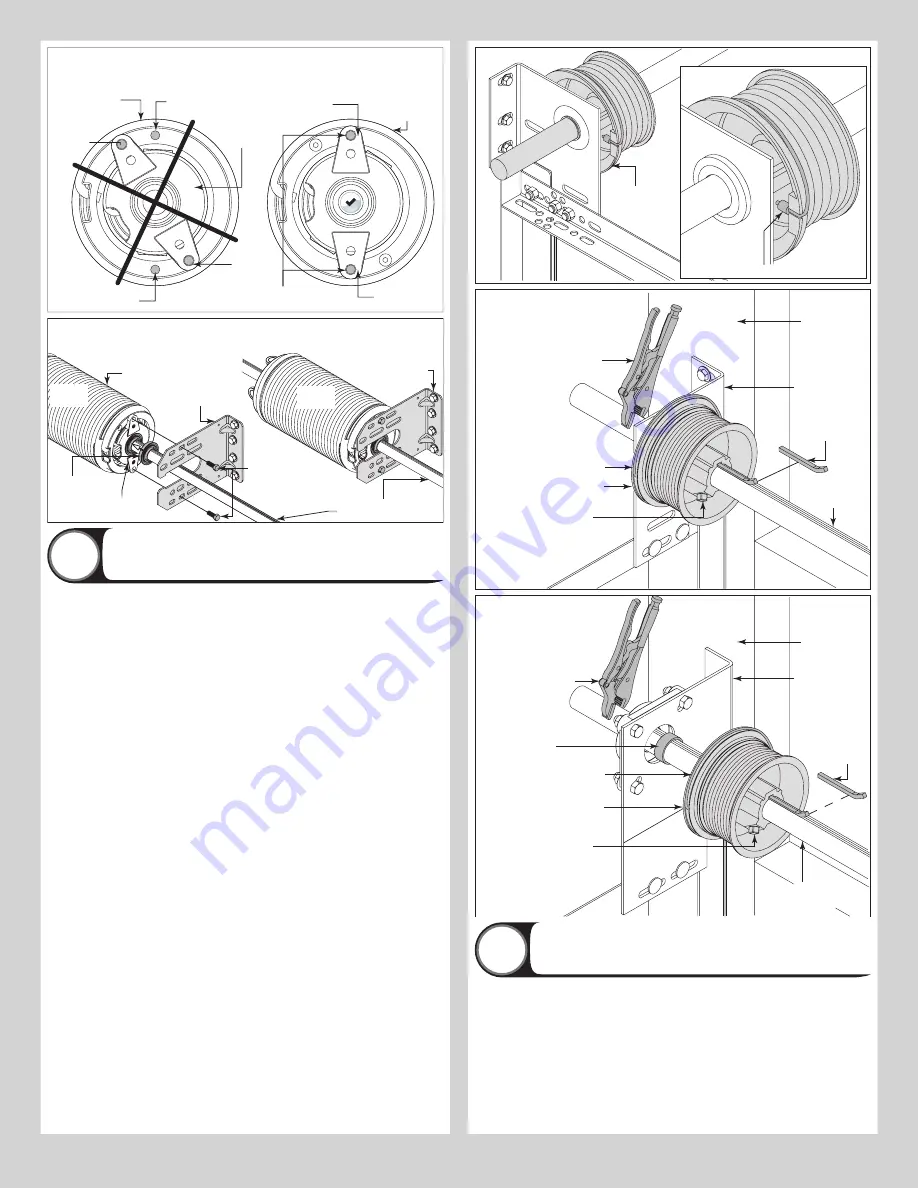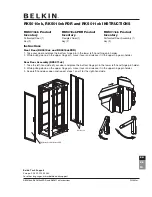
Outer torsion
spring assembly
Bolt hole for
outer spring cone
Inner torsion
spring
assembly
Bolt hole
for inner
spring
cone
NOTE:
Prior to securing the center bracket to the torsion spring, ensure The bolt goes through
the inner spring cone and threads into the outer spring cone.
Bolt holes for outer spring cone
and inner spring cone aligned
Outer torsion
spring assembly
Inner torsion
spring assembly
Inner torsion
spring assembly
Bolt hole for inner
spring cone
Bolt hole
for outer
spring cone
6” Duplex Springs Applications
3/8” - 16 x 1”
Hex head
screws
Outer torsion
spring assembly
Center bracket
Center
bracket
Torsion shaft / Torsion
keyed shaft(s)
Inner torsion
spring assembly
Flange
bearing
Duplex
springs
NOTE:
This type of torsion spring assembly has both an outer spring and an inner spring
assembly.
Duplex
springs
6” Duplex Springs Applications
Attaching Counterbalance Lift Cables
24
Starting on the left hand side, thread the counterbalance lift cable up and around the front
side of the left hand cable drum.
IMPORTANT:
VERIFY THAT THERE ARE NO OBSTRUCTIONS IN THE TRAVEL PATH OF THE
DOOR SECTIONS OR COUNTERBALANCE LIFT CABLES.
NOTE:
Always assemble the left hand cable and cable drum first to help maintain equal cable
tension on both sides of the door.
Hook the counterbalance lift cable into the left hand cable drum. Slide the left hand cable
drum up against the left hand end bearing bracket / spacer. Counterbalance lift cable should
terminate at the 3 o’clock position.
NOTE:
If you have torsion keyed shaft(s), insert (1) key into the slot of both the cable drum
and the slot in the torsion keyed shaft, as shown.
FOR SPRINGS UP TO 3-3/4” ID:
Tighten the (2) set screws in the drum to 14 - 15 ft. lbs. of
torque (once set screws contact the shaft, tighten screws one full turn).
FOR 6” AND DUPLEX SPRINGS:
Tighten the (4) set screws in the drum to 25 ft. lbs. of
torque (once set screws contact the shaft, tighten screws 1/2 to 1 full turn).
At the middle of the two center bearing brackets, loosen the (3) 3/8” - 16 x 1-3/4” hex head
screws and the (3) 3/8” - 16 nylon hex lock nuts from the coupler assembly (if applicable).
Rotate the left hand drum and torsion shaft until counterbalance lift cable is taut. Now attach
locking pliers to the torsion shaft and brace locking pliers up against jamb to keep counter-
balance lift cable taut. Repeat for right hand side.
At the middle of the two center bearing brackets, tighten the (3) 3/8” - 16 x 1-3/4” hex head
screws and the (3) 3/8” - 16 nylon hex lock nuts from the coupler assembly (if applicable).
IMPORTANT:
INSPECT EACH COUNTERBALANCE LIFT CABLE MAKING SURE IT IS SEATED
PROPERLY ONTO THE CABLE DRUM AND THAT BOTH COUNTERBALANCE LIFT CABLES HAVE
EQUAL TENSION.
CHECK COUNTERBALANCE LIFT CABLES FOR EQUAL TENSION:
1. Attach locking pliers to track above top roller.
2. Grasp cable at approximate mid-door height location.
3. Draw cable toward you about 1/2” to 1” and release, noting the response of the cable.
4. Repeat above steps for other cable.
5. Adjust cable tension as needed until right and left cables both respond the same.
Once the counterbalance cables are set and if applicable tighten the coupler assembly
together by tightening the (3) 3/8” - 16 nylon hex nuts to secure the coupler halves together.
Left cable drum
Counterbalance cable hooked in cable drum
Left cable drum
Counterbalance lift cable
Locking pliers
Set screws
Jamb
Left end
bearing bracket
Torsion keyed
shaft
Key
Counterbalance lift cable
Locking pliers
Set screws
Jamb
Key
Typical left hand
cable drum
Torsion shaft /
Torsion keyed shaft(s)
Left hand end
bearing bracket
with dodge
bearing (optional)
Drum spacer
NOTE:
Prior to securing the
cable drum to the torsion shaft
/ torsion keyed shaft, position
the cable drum tight up
against the drum spacer.
Chalking Torsion Spring(s)
25
NOTE:
If your springs have stenciling, then skip this step.
Draw a chalk line horizontally along the center of the torsion spring coil(s). As the torsion
spring is wound, the chalk line will create a spiral. This spiral can be used to count and
determine the number of turns that are applied on the torsion spring.
11


































